Weerasak Kowsurat, Chairman, Thailand Convention & Exhibition Bureau (TCEB): Interview

Interview: Weerasak Kowsurat
How has significant growth in tourism contributed to the meetings, incentives, conferences and exhibitions (MICE) segment in Thailand?
WEERASAK KOWSURAT: Thailand enjoyed a significant boost in tourist arrivals over 2016, and the MICE industry made a significant contribution to this tourism growth. MICE travellers spent an average of 3.5 times more than the average leisure traveller during their stay in Thailand, and the industry contributed $3.2bn to the national GDP over 2016. A study conducted in 2015 calculated the industry’s total contribution to GDP that year to stand at $6.3bn, generating 164,427 jobs, all while benefiting industry networking, brand building, and improving the calibre and capabilities of the nation’s MICE professionals. In 2016 Thailand welcomed 1.3m MICE travellers, up 15.8% from the previous year’s figures, while projected revenue growth was more modest at 6.9%, up to $2.9bn. In 2017 we anticipate a slight tapering off in growth in line with current global trends. Despite this, the pattern is clear that the MICE segment is playing an increasingly important role in generating income for the nation, while making significant direct and indirect upgrades to both its human resources capacity and international standing.
What advantages does Thailand hold over regional neighbours in the MICE industry?
WEERASAK: To answer this question one must look at what truly distinguishes Thailand and makes it a unique MICE destination. We can point to many things, including its convenience, infrastructure, safety, venues, services and its location at the heart of ASEAN. Thailand absolutely competes with the highest-ranked destinations on all these fronts. The 2016 Global Destination Cities Index ranked Bangkok first worldwide, taking the place of London as the top global destination city by number of visitors. Furthermore, Bangkok has a total of six large-scale convention and exhibition centres. While all these quantitative comparisons are important, where I truly see Thailand differentiating itself from other Asian destinations is first in its price point, which in terms of value for money is second to none. Secondly, in terms of the visitor experience, we probably have the region’s broadest range of opportunities for cultural, educational and leisure activities that complement business travel – a convergence that is playing a key role in the MICE sector’s growth.
What national agenda items might serve to boost MICE-related activity moving forward?
WEERASAK: Thailand is now undergoing significant economic development through several projects and ideas prioritised under the national agenda, many of which will create new opportunities for the MICE segment in the short term. Foremost is the Digital Thailand initiative, under which new legislation is being introduced that will create and develop digital infrastructure in the country’s Eastern Economic Corridor (EEC). This has already drawn a great deal of attention from many investors in digital fields, and naturally helps bolster Thailand’s position as a regional MICE hub for these sectors. Another initiative is the Thai Food to the World project, which is drawing domestic and international farmers, livestock breeders, food processors and other related stakeholders to Thailand to discuss how best to advance the food industry into higher-value segments such as biotechnology and food medicine.
Looking at national infrastructure developments, the renewed focus on developing China-ASEAN railway connectivity will lead to a very significant rate of development in the north-east region of Thailand, which contains the nation’s largest population. Improved connectivity with China and Indochina will draw business and, in turn, MICE demand to these regions. These are a few examples of the endless opportunities for increased MICE activity across Thailand, which will strengthen our position as a networking destination, and develop better ways to live and do business in Asia.
You have reached the limit of premium articles you can view for free.
Choose from the options below to purchase print or digital editions of our Reports. You can also purchase a website subscription giving you unlimited access to all of our Reports online for 12 months.
If you have already purchased this Report or have a website subscription, please login to continue.

